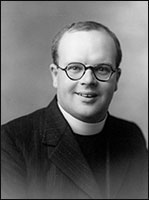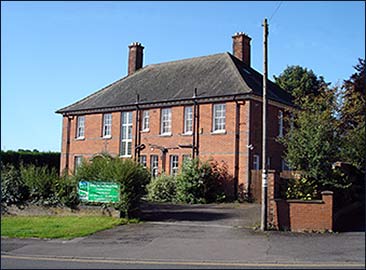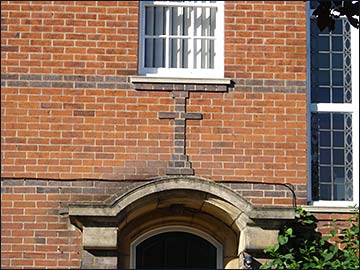In 1914 St. Peter’s magazine began as a separate publication – though the series of bound copies began only in 1919.
First Vicarage
The Vicarage scheme was begun in 1917 and No.2 Gordon Street was bought for £349 – of which about £200 had been paid off by early 1918 when the Reverend A.J.Meakin succeeded Mr Richards. He organised a free will offering scheme which raised a further £100 for the fund. He died in the influenza epidemic of that year and was buried two days before Armistice Day (Nov.11th 1918).
New Vicarage
The Reverend Ion Carroll became the third Vicar of St. Peter’s in January 1919. The final £50 of the Vicarage Fund was raised, then a scheme for a new and better Vicarage was begun. The parish was to raise £500, then the Diocesan Authorities would add £200 and the Ecclesiastical Commissioners £700. At first it was thought that the house could be built on the church lawn, but as this was rather small, another site was looked for. Finally in 1927, a site was bought in Wellingborough Road and a resolution to start the building was passed in 1929. The house was designed by Talbot, Brown and Fisher – “a house of dignified appearance, full of character and pleasing to the eye”. The £500 still needed from the parish was to be raised by subscription from members of the congregation, either in one lump sum or by instalments over 4 years. Apparently some people felt that the house was too large – with 5 bedrooms and many rooms downstairs including a maid’s sitting room and china pantry – but the church authorities of the day described it as a “model vicarage”. Its first occupant who moved in in March 1930 was the Reverend P.Barwell Spriggs who had become Vicar in 1927 and followed the Anglo-Catholic tradition established by the Rev. Ion Carroll.
Curates
The Rev. Ion Carroll felt that the work at St. Peter’s and the number of services necessitated an assistant priest (or curate) and with the help of grants from the Additional Curates’ Society and the Diocese, the first curate – the Reverence V.F.Honniball was appointed in October 1920.
Social Centre
This was established on the corner of Irchester Road with Wellingborough Road, on land bought at a very reasonable price from Mr R.Marriott. It was to be run by the Church Army, with a Captain in charge living on site, who would organise Sunday night mission services, young men’s bible classes, week‑day social and general work. Capt. W.J.Terry was the first Church Army captain in charge. The work here was short lived; in 1925 it was decided to sell the site and put the money into the Vicarage Fund.
Changes in Services
The Rev. Ion Carroll, who followed the Catholic tradition of the church, began a Choral Eucharist on Sunday mornings, with a daily celebration of Holy Communion, and the use of vestments, (first used on Christmas Day 1919). He also replaced Hymns Ancient and Modern with the English Hymnal.
The Font
For some time there had been plans for a permanent font. This was finally designed by Mr Talbot Brown, constructed by Robert Marriott Ltd and dedicated in September 1922 by the Bishop of Leicester. This was in thanksgiving for a very successful mission held in December 1921.
Highfield Hall
 |
|
Rev A J Stevens
|
During the time that the Rev. P.Barwell Spriggs was Vicar, there had been further expansion of the towns, mainly off Irchester Road, and therefore in 1934 plans were made for a Mission Hall and School.
Land in Highfield Road was bought from the Rushden Urban District Council for £39.15s. in 1935 and in the same year the Rev. A.J.Stevens was appointed curate to work mainly on that housing estate and with young people. Everyone was asked to help raise money for the New Hall (but “not by raffles, draws or games of chance”) and the building was begun. In July 1936 an open air service was held near the Hall with a good attendance and the Hall itself was dedicated by the Bishop of Peterborough in December 1936. He said, “It is a dark December day but in this place are light and hope for the future”.


